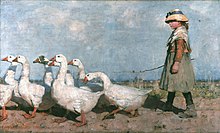|
James Guthrie (artist)
   Sir James Guthrie PPRSA (10 June 1859 – 6 September 1930) was a Scottish painter, associated with the Glasgow Boys. He is best known in his own lifetime for his portraiture, although today more generally regarded as a painter of Scottish Realism. Early life and education Guthrie was born in Greenock, the youngest son of the Rev. John Guthrie, a minister of the Evangelical Union church,[2] and Anne Orr. He originally enrolled at Glasgow University to study law, but in 1877 abandoned this in favour of painting. Unlike many of his contemporaries he did not study in Paris, being mostly self-taught, although he was mentored for a short time by James Drummond in Glasgow and then John Pettie in London.[3] In 1879, he moved to London to study painting. during the summer he painted at rural locations, often Rosneath and Helensburgh but mostly at Cockburnspath.[4] Guthrie spent some time[when?] with his friend Edward Arthur Walton living in Cheyne Walk in Chelsea[5] CareerGuthrie lived most of his life in the Scottish Borders, since 1883 in Cockburnspath, Berwickshire, where he painted some of his most important works, including A Hind's Daughter (1883), and Schoolmates (1884).[6] He was strongly influenced by the French Realists, especially Jules Bastien-Lepage, and was associated with the Glasgow Boys.[3] In 1888, he was elected an associate of the Royal Scottish Academy, and a full member in 1892. In November 1902 he was unanimously elected to succeed Sir George Reid as RSA president,[7] and he moved with his family from Glasgow to Edinburgh.[4] In 1903, he was knighted. A member of Glasgow Art Club Guthrie exhibited often at the club's annual exhibitions.[8][9] In 1919, Guthrie was commissioned by South African financier Sir Abraham Bailey, 1st Baronet to paint a group portrait of 17 politicians and statesmen of Britain and its allies who held office during the First World War. The painting, Statesmen of World War I, was completed in 1930, shortly before Guthrie's death. The painting was donated to the National Portrait Gallery, London. Guthrie's 17 preparatory oil studies were donated to Scottish National Portrait Gallery. In 1920, the King of Belgium conferred Guthrie with the Cross of Commander of the Order of the Crown.[3][10] In 1921, he joined the newly-formed Society of Graphic Art, and exhibited with them in 1921. Personal life and deathIn the late 1880s Guthrie met Helen Newton Whitelaw, a wealthy widow at her family home, Rowmore, in Rhu, Dunbartonshire. They married in 1897 and in 1899 their son Thomas Whitelaw Boyd Guthrie was born in Chelsea, London. On October 20, 1912 she died of cancer at the age of 52.[4] Guthrie died in the house of his retiral in 1930.[3] His grave in Rhu was designed by the architect Alexander Nisbet Paterson.[4] Work By 1885, Guthrie was a reputable portrait painter and in later life he virtually abandoned other subjects. He was commissioned by many of the rich and famous of his day to paint their portraits. The list is quite impressive:
References
Further reading
External linksWikimedia Commons has media related to James Guthrie.
|